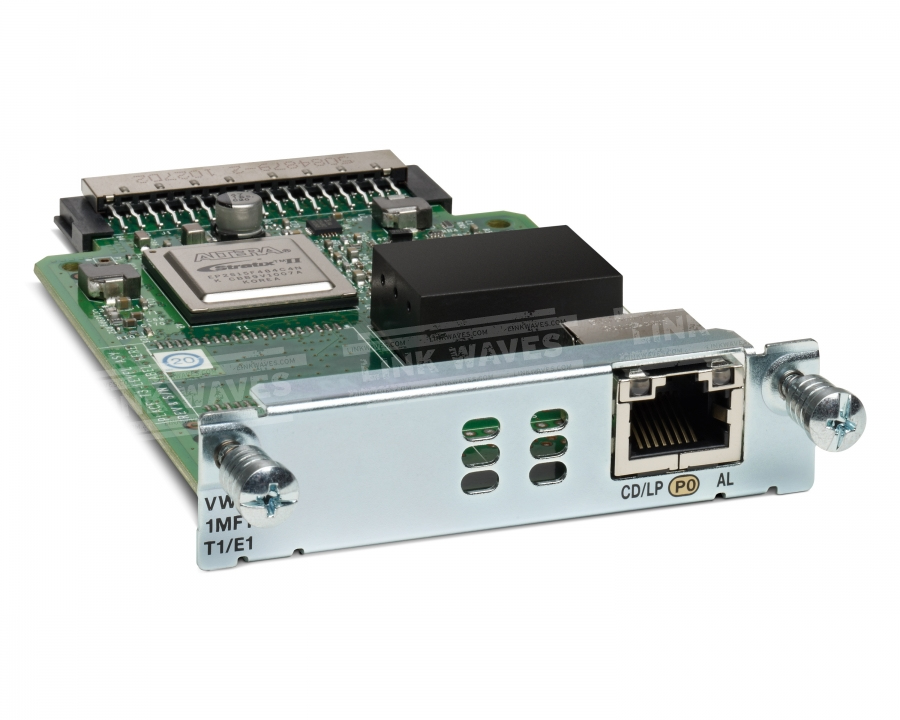Banner

Danh mục sản phẩm
Hỗ trợ trực tuyến

Mr Thanh Hiền
![]() 0933 64 94 64
0933 64 94 64
![]() daohien5285
daohien5285
Mr Trung Hiếu
![]() 0961 718 333
0961 718 333
Mr Tuấn Lee
![]() 0906 634 366
0906 634 366
Ms Phượng Quỳnh
![]() 093 302 1398
093 302 1398
Mr Khải Phước
![]() 08 3333 1213
08 3333 1213
![]() DuongKhaiPhuoc
DuongKhaiPhuoc
Thống kê truy cập
VWIC3-1MFT-T1/E1
VWIC3-1MFT-T1/E1
0
VWIC3-1MFT-T1/E1 Cisco Voice/WAN Card VWIC3-1MFT-T1/E1 VWIC3-1MFT-T1/E1 Overview The Cisco Third-generation 1-, 2-port and 4-port T1/E1 Multiflex Trunk Voice/WAN Interface (MFT VWIC3s) support data and voice applications on the Cisco 1921, 1941 and 1941W (data only), and the Cisco 2901, 2911, 2921, 2951, 3925, 3945, 3925E and 3945E Integrated Services Routers. The Cisco MFT VWIC3 combines WAN-interface-card (WIC) and voice-interface-card (VIC) functions to provide unparalleled flexibility, versatility, and investment protection through its many uses. Customers who choose to integrate data and voice in multiple steps preserve their investment in a T1/E1 WAN interface because the Cisco MFT VWIC3 cards can be
VWIC3-1MFT-T1/E1
Cisco Voice/WAN Card VWIC3-1MFT-T1/E1
VWIC3-1MFT-T1/E1 Overview
The Cisco Third-generation 1-, 2-port and 4-port T1/E1 Multiflex Trunk Voice/WAN Interface (MFT VWIC3s) support data and voice applications on the Cisco 1921, 1941 and 1941W (data only), and the Cisco 2901, 2911, 2921, 2951, 3925, 3945, 3925E and 3945E Integrated Services Routers. The Cisco MFT VWIC3 combines WAN-interface-card (WIC) and voice-interface-card (VIC) functions to provide unparalleled flexibility, versatility, and investment protection through its many uses. Customers who choose to integrate data and voice in multiple steps preserve their investment in a T1/E1 WAN interface because the Cisco MFT VWIC3 cards can be reused in packet voice applications.The Cisco MFT VWIC3 interface cards add improvements over the Cisco Second-generation 1- and 2-port T1/E1 Multiflex Voice/WAN Interface Cards (MFT VWIC2s). The Cisco 2- and 4-port MFT VWIC3s enable each port to be clocked from an independent clock source for data applications. Voice applications can now be clocked independently from data applications, with all ports for voice applications clocked from a single source. The Cisco MFT VWIC3s use the ECAN on the motherboard PVDM cards with up to 128ms echo-tail length for demanding network conditions. MFT VWIC3 cards support up to 2 channel groups per T1/E1 port for serial data applications. Refer to Table 3 for all configuration options offered with the MFT VWIC3 cards.
The Cisco MFT VWIC3 cards can be inserted into the EHWIC slot on the supported Cisco 1921, 1941, 1941W, 2901, 2911, 2921, 2951, 3925, 3945, 3925E and 3945E integrated services routers. The T1/E1 MFT VWIC3 cards support both T1 and E1, providing additional flexibility in configuring the Cisco MFT VWIC3s for supporting T1, fractional T1, E1, and fractional E1 for both voice and WAN applications. All MFT VWIC3 modules include the drop-and-insert multiplexing capability, which eliminates costly external third-party channel service units/data service units (CSUs/DSUs) and drop-and-insert multiplexers.
The Cisco MFT VWIC3 cards are offered in single-, dual- and quadruple-port versions, which can be used and then redeployed as network requirements change, thereby addressing several applications:
- T1/E1 data: The Cisco 1-, 2- and 4-port T1/E1 MFT VWIC3 versions act as a WIC, supporting T1, fractional T1, E1, (including structured G.703 with G.704 framing), fractional E1, and E1structured G.703 applications. To simplify remote management, these MFT VWIC3 cards integrate a fully managed DSU/CSU for T1 deployments and a fully managed DSU for E1 deployments.
- E1/G.703 data: The Cisco 1- and 2- port G.703 MFT VWIC3 versions act as a WIC, supporting T1, fractional T1, E1 (including structured G.703 with G.704 framing), fractional E1, and unstructured E1 (G.703) applications. To simplify remote management, the G.703 version includes a fully managed DSU. The G.703 versions also support all the capabilities on the T1/E1 versions.
- T1/E1 packet voice: The Cisco 1-, 2- and 4-port T1/E1 MFT VWIC3 (voice and WAN) versions act as a VIC, supporting packet voice applications by providing T1, fractional T1, E1, and fractional E1 connections to private branch exchanges (PBXs) and central offices, thereby enabling new services and reducing voice and fax toll charges.
- Mixed data and packet voice: The Cisco MFT VWIC3 interface cards can simultaneously support both data and voice, reducing the complexity and number of network components and facilitating a graceful migration to bandwidth-efficient packet voice.
- Mixed data and packet voice with drop and insert: The Cisco MFT VWIC3 cards can be deployed as a T1/E1 drop-and-insert multiplexer with integrated DSUs/CSUs, reducing the complexity of the network and the cost of the central-office ports by efficiently combining time-division multiplexing (TDM) voice (PBX), IP voice, and data on the same trunks. Cisco 1900, 2900 and 3900 ISR routers support drop and insert between ports over a single MFT VWIC3 card and two ports over two different MFT VWIC3s
VWIC3-1MFT-T1/E1 Specification
|
VWIC3-1MFT-T1/E1 |
|
|
Manufacturer |
Cisco |
|
Part Number |
VWIC3-1MFT-T1/E1 |
|
Device Type |
Interface module |
|
Form factor |
1-Port T1/E1 Multiflex Trunk Voice/WAN Interface Card |
|
Specifications |
|
|
Number of Ports |
1 |
|
T1 Support |
Yes |
|
E1 Support |
Yes |
|
Unstructured E1 (G.703) Support |
No |
|
Data Support WIC Mode |
Yes |
|
Voice Support VIC* |
Yes |
|
Drop-and-Insert Multiplexing |
Yes |
|
Configuration Comparison |
|
|
Serial Data (channel-group*) |
2 total |
|
Voice CAS (ds0-group**) |
24 total (T1) |
|
PRI (pri-group***) |
1 total |
|
Drop & Insert (tdm-group****) |
24 total (T1) |
|
Network Management Features |
|
|
Telnet or Console |
Remote and local configuration, monitoring, and troubleshooting from Cisco IOS Software CLI |
|
Simple Network Management Protocol (SNMP) |
• Router and DSU/CSU managed by single SNMP agent; router, DSU, and CSU appear as a single network entity to user • Standard MIB (MIB II) • Cisco Integrated DSU/CSU MIB • RFC 1406 T1 MIB, Including Alarm Detection and Reporting |
|
SNMP Traps |
Generated in response to alarms |

